The Art of Adolf Hitler a Study of His Paintings and Drawings
Adolf Hitler is i of history's most infamous dictators. After coming to power as Führer of Nazi Deutschland, he and his followers were responsible for the deaths of millions, non to mention the earth's greatest mass theft and destruction of priceless artworks. Notwithstanding, what you may not know is that Hitler originally dreamed of being an artist and actually created fine art, mainly paintings.
Equally a young kid growing up in Linz, Republic of austria, Hitler knew he wanted to be an artist. He even received substantial encouragement from his adoring mother in his pursuits. However, the stereotypical creative person's life is not one almost parents desire to see their children fall into, especially an ill-tempered, stern, civil servant like Alois Hitler, Adolf's father. Alois probably shared some of the same sentiment. He frequently beat his son and refused to acknowledge his artistic ambitions. In an attempt to put Adolf on a more stable path, he enrolled him in a technical school.
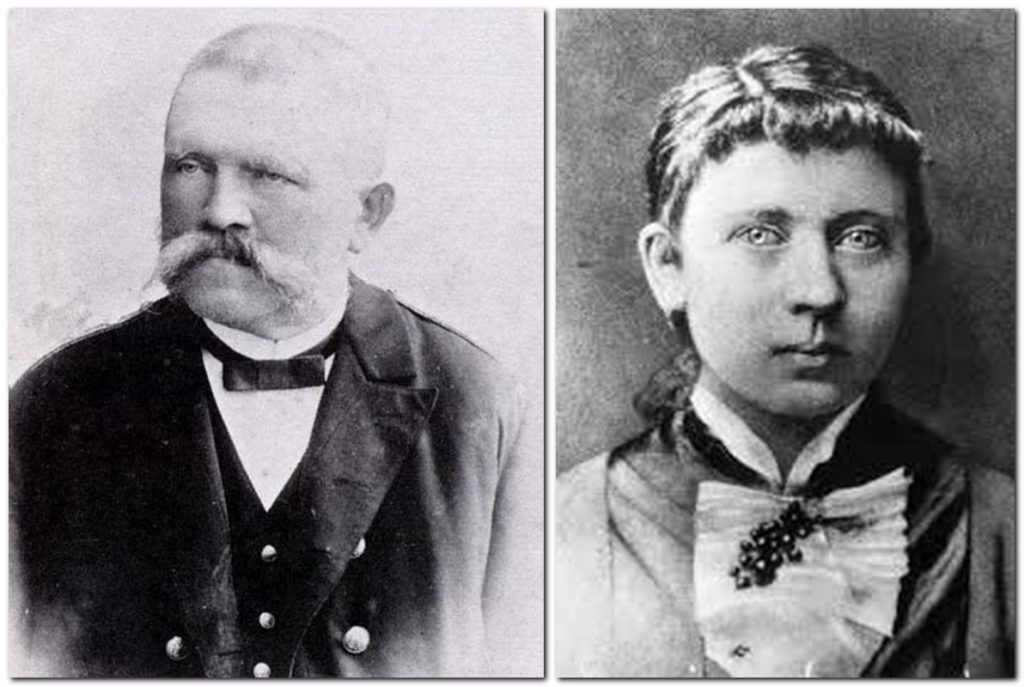
A few years into the plan, Hitler's father died. While there was probably temptation to exit technical school in his male parent's absence, he completed the program with an average record. He graduated in 1905 and remained in Linz to care for his ailing mother until she passed in December of 1907.
Hitler Moves to Vienna
Information technology was then in 1908 that xviii-year-old Hitler moved to Vienna – the beautiful, fine art-centric majuscule of the Austria-hungary. Hitler saw Vienna every bit the ideal place to pursue his childhood dream. While his longtime friend and roommate, Baronial Kubizek, was immediately accepted into a music conservatory, Adolf struggled to observe the artistic success he had hoped for.
Before moving, Hitler had already practical to the Vienna University of Fine Arts. He passed the initial exam merely the admissions committee found his drawing skills unsatisfactory. Naturally, Hitler wasn't a fan of rejection and became upset at this news. In the meantime, he kept busy sketching, rubbing elbows with other artists in the city, studying, and attempting to earn a living every bit a worker and artist.
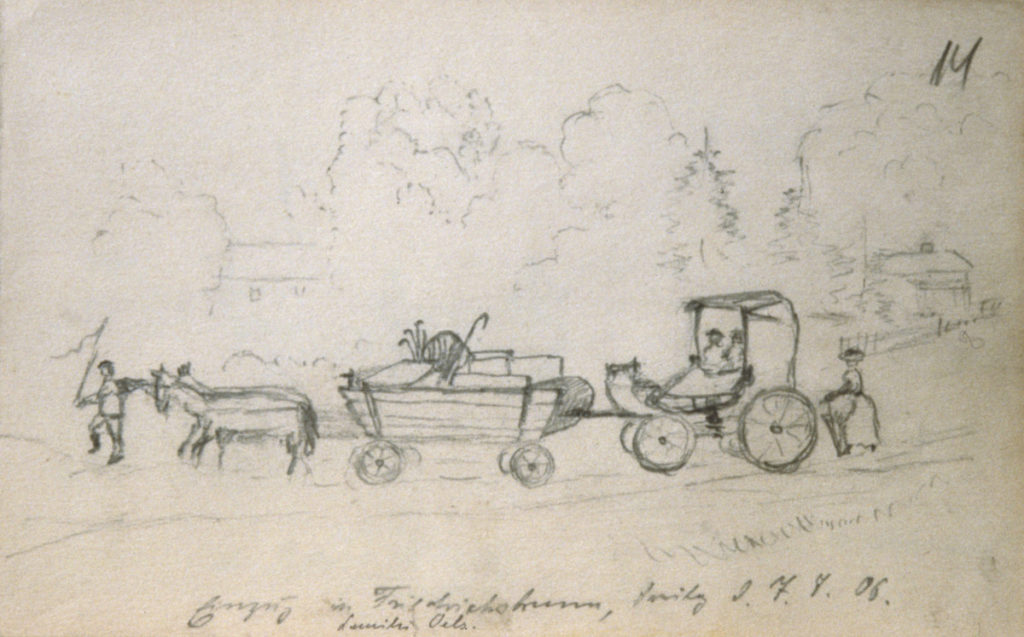
During the autumn of 1908, Hitler practical to the Arts Academy once more, simply to be rejected again. The professors suggested he apply to architectural schoolhouse instead as his skills seemed better suited to that field. However, Adolf was not fond of that idea; he was fixated on becoming an artist. In his autobiography, Mein Kampf, Hitler wrote that the rejection came "as a bolt from the blue." He was so sure he would succeed. Alas, the universe had other plans for Adolf Hitler.
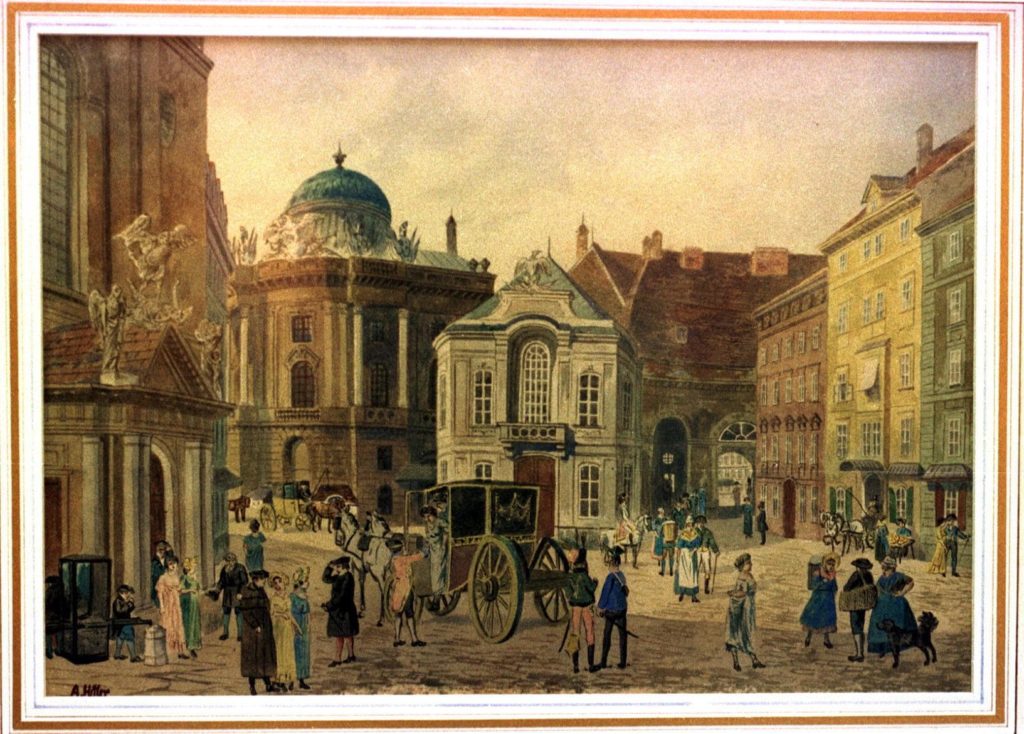
While recent inquiry suggests he may have received a substantial loan from his family to comprehend his living expenses, Hitler spent much of the next year without a permanent place of residence. He moved from 1 cheap room to another and even lived in a homeless shelter for a bit.
In 1909, Adolf finally began to get his anxiety nether him. He had reasonable success selling his small watercolor and oil paintings depicting landmarks and metropolis-scapes of Vienna to tourists and frame-sellers. Ironically, these were paintings he copied from postcards, not wholly original artistic content. Regardless, the funds he accrued from his sales allowed him to trade his spot at the homeless shelter for a room in a men's home.
While he was standing to draw and pigment, Adolf became increasingly frustrated with art and took a fateful interest in politics. In Mein Kampf, Hitler states this period gave rise to his Antisemitism. While his time in Vienna greatly shaped young Hitler's world views, historians uncertainty this simple explanation, possibly placing more than weight on his tumultuous family life. One of the greatest contradictions of this period is his admiration for Vienna's then-mayor and known anti-Semitic, Karl Lueger and the fact that Hitler's primary patron in Vienna was Samuel Morgenstern, a Jewish store owner. One possible explanation could be desperation. Mayhap, Hitler was in such dire need of income or a feeling of success, he resorted to doing business with the very people he would one day try to wipe from Deutschland.
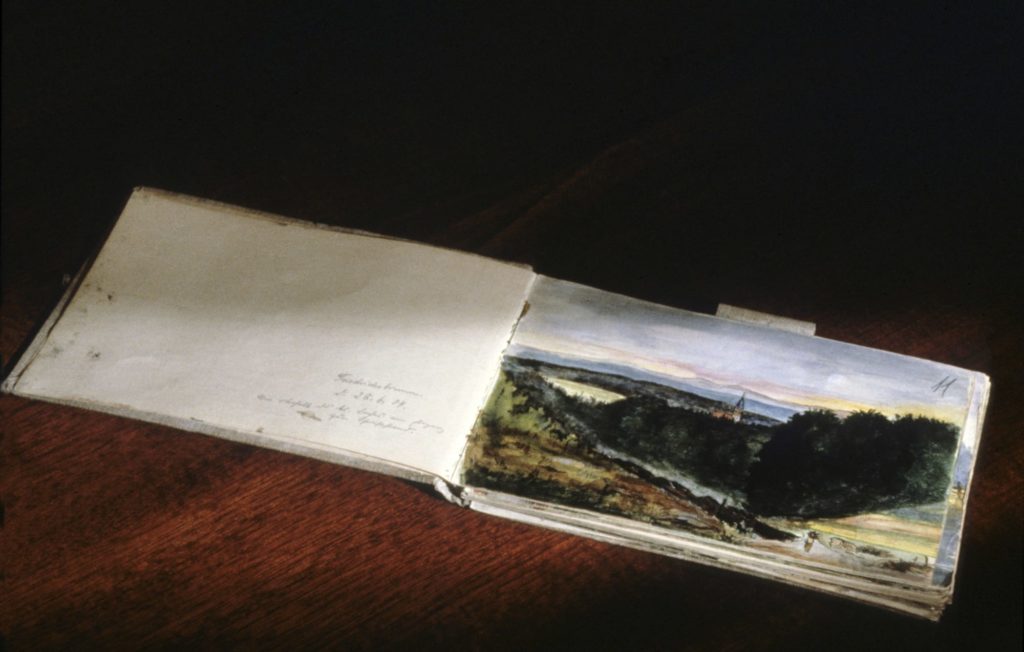
On to Munich
In May of 1913, Hitler moved to Munich. He plant success in a similar manner, selling small watercolor and oil paintings depicting cityscapes and landmarks of Munich. Adolf also found several wealthy patrons who kept him afloat by commissioning works from him. But that all came to a screeching halt in 1914 when the Munich police tracked him downwardly for failing to annals for the military while in Linz.
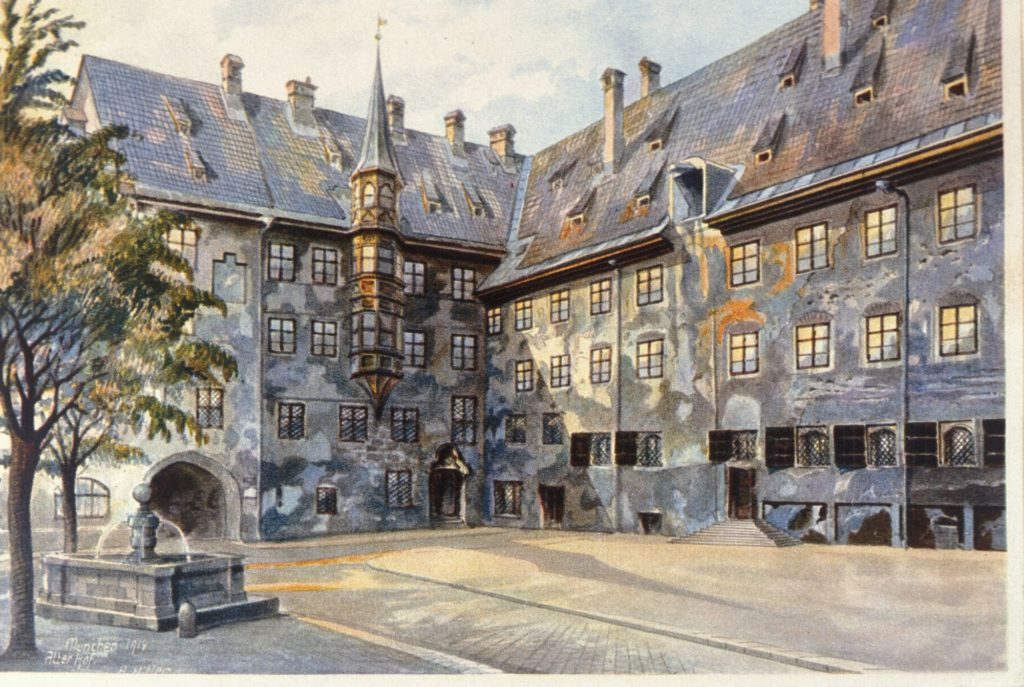
But young Hitler also failed his armed forces fitness test. The examiners declared he was "unsuitable for combat and support duty, too weak, incapable of firing weapons." Still, in August of that year, Adolf Hitler voluntarily enrolled subsequently World State of war I broke out, bringing an end to his career as a struggling young creative person.
Adolf Hitler'due south Art Vendetta
Without a doubtfulness, the fourth dimension Hitler spent in Vienna and his derailed art career contributed to the theatrical myth-making Hitler and his followers used to fuel his rise to power. His desire to purify the German country did not stop at exterminating Jews, Gypsies, people of color, homosexuals, Jehovah's witnesses, and Nazi dissenters. He also sought to purify the civilisation by rallying confronting modern art, calling it a "degenerate" product of the Bolsheviks and Jews. Perhaps this is simply conjecture, but i could presume his own artistic tastes and shortcomings could have played a part in his views of modern art.
In 1937, Hitler had about sixteen.ooo "degenerate" works of art gathered upward from German museums past his henchmen. Among them were abstract, non-representational, and modern works by some of art'southward most famous names, such equally Wassily Kandinsky and Paul Klee, as well as works by Jewish artists. The exhibition booklet dictated that the aim of the show was to reveal the "philosophical, political, racial and moral goals and intentions behind this movement and the driving forces of corruption which follow them." The show appeared thrown together with little care; the walls were plastered with graffiti, the artworks were arranged in a crowded manner, and the paintings hung crooked. All to reinforce the belief that this art was disreputable. The museum even hired actors to mingle in the crowd and criticize the art.
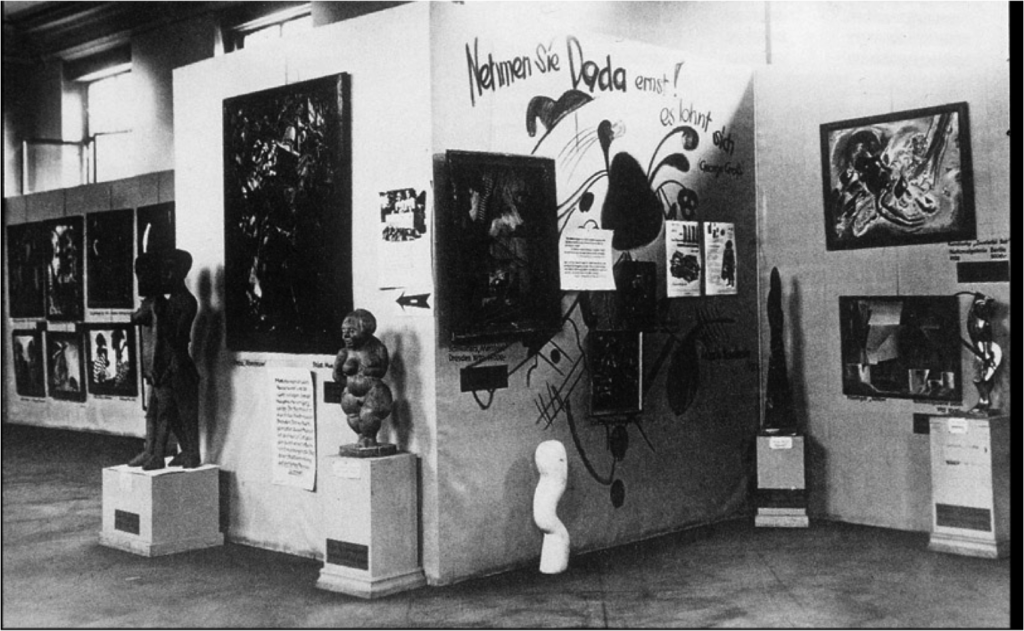
Ironically, the exhibit attracted nearly ii million viewers, even though its master intention was to create disdain. The testify then went on tour in Federal republic of germany, where at least a million more people had a chance to see it. While some attendees sided with the Nazi'due south disapproval of this work and some that went simply for the scandal of it all, there were simply as many, if not more than, who attended the evidence because they felt it could be their last risk to see this type of work in Germany.
At the same time, Hitler had bundled a juxtaposing, more superior art exhibit, The Peachy German Fine art Exhibition. This showcase of Hitler-approved-art included picturesque blonde nudes every bit well equally idealized landscapes and soldiers, reflecting Hitler'southward own traditional, unoriginal tastes. However, this show had a much lower omnipresence rate, which could be opposite of Hitler'due south vision for these shows. Maybe it is condom to say this left Hitler'south ego a piffling damaged.
The Paintings of Adolf Hitler
After coming to ability in Frg, Hitler supposedly had most of his art collected and destroyed. However, in that location are nonetheless several hundred in collections around the world. Four of his watercolors are now owned by the United States Army after existence confiscated during World War II. In add-on, the International Museum of World War 2 in the U.S. houses one of the largest collections of Hitler's art.
In Germany, it is in fact legal to sell works bearing the infamous dictator'southward signature and so long every bit they do not draw Nazi symbols. When they practice come up for sale, they are guaranteed to stir controversy. In a 2015 auction in Nuremberg, fourteen works by Hitler sold for $450,000. While many do not concur with the sale of items directly related to a nighttime, troubling historical period or figure, the auction house dedicated their decision by arguing the historical importance of the works.
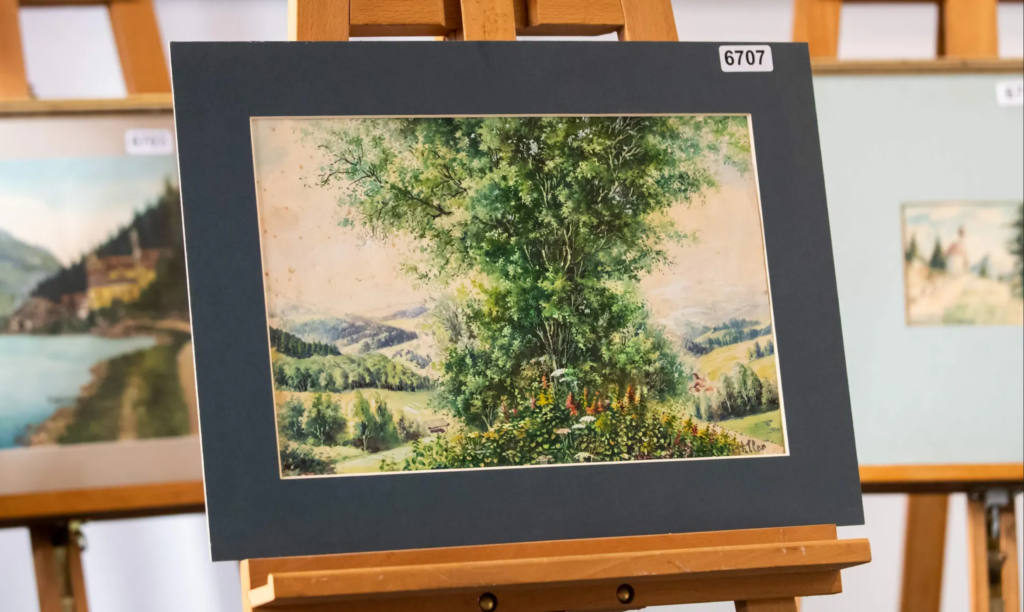
However, historical and moral controversy isn't all these paintings get together when they do come upwards for auction. Questions regarding their authenticity frequently arise, too. Just last yr, 2 sales of Hitler'south work failed due to forgery concerns. In January of 2019, police raided Berlin's Kloss auction house and seized 3 watercolors believed to be forgeries. Most a month later, more suspicions arose during a auction of Nazi memorabilia, including 5 paintings attributed to Hitler. The rumors of fraud and high starting prices ($21,000- $l,000) scared off potential buyers, leaving the paintings on the sale cake. Nuremberg's mayor condemned the sale, stating it was "in bad taste."
Heinz-Joachim Maeder, a spokesperson for Kloss auction house, in one case said the high prices and media interest surrounding Hitler's work are merely due to the name signed on the works, suggesting they take niggling, if any, creative or art historical value.
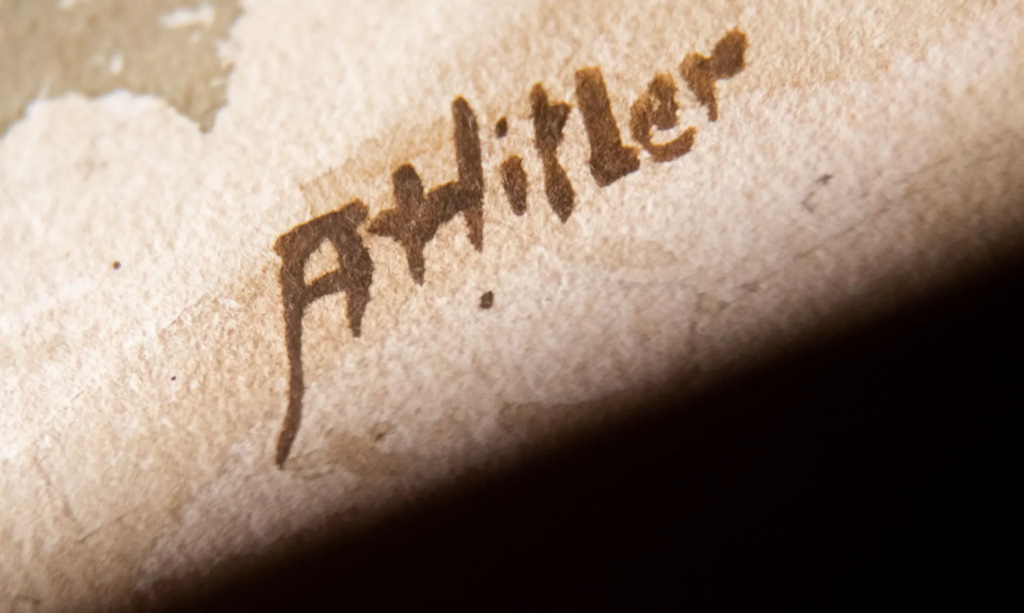
Why is it so hard to verify Hitler's work?
Stephan Klingen of Munich's Cardinal Plant for Art History states Adolf's piece of work is hard to verify considering his fashion is that of a "moderately ambitious amateur." Therefore, his creations exercise non stand out among hundreds of thousands of like works from this menstruation. After all, Hitler was, for the most part, copying work he saw on postcards, art done past painters of the German school, and practicing what little technique he learned on his own. This means there are very few ways to become almost identifying elements that are unique to Hitler'due south style while simultaneously making it that much easier for skilled forgers to re-create his work.
In 1936, American art critic, John Gunther, wrote the post-obit on Hitler's paintings:
"They are prosaic, utterly devoid of rhythm, color, feeling, or spiritual imagination. They are architect's sketches painful and precise draftsmanship; nothing more. No wonder the Vienna professors told him to become to an architectural schoolhouse and give up pure art as hopeless."
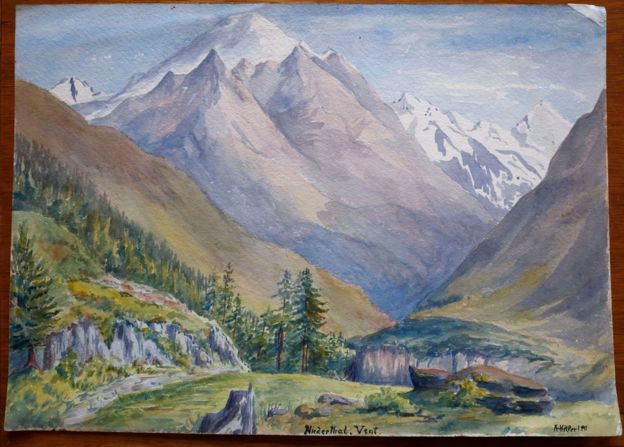
Today, critics are still giving Hitler's piece of work negative reviews. Pulitzer Prize-winning art critic, Jerry Saltz, said the following to NPR regarding Hitler'southward piece of work in 2019:
"Physically and spatially dead generic academic realism, the equivalent of mediocre exercises in aping good penmanship. He was an acceptable draftsman, utterly unimaginative, and made the equivalent [of] greeting cards."
During 2002, Frederic Spotts, author of Hitler and the Power of Aesthetics, showed an art critic several of Adolf Hitler's paintings, without telling him who the artist was. According to Spotts, the critic'due south starting time remarks were that the works were "quite good." He so commented on the manner in which the humans in the paintings were portrayed, stating this suggests the artist's "disinterest in the human race." After researching Hitler and his psyche for decades, scholars believe his paintings nod towards his sociopathic tendencies. Marc Fisher of the Washington Post wrote:
"Is it possible to look at these antiseptic street scenes and run into the roots of Hitler's obsession with cleanliness and his belief that his mission in life was to cleanse Frg and the world of Judaism?"
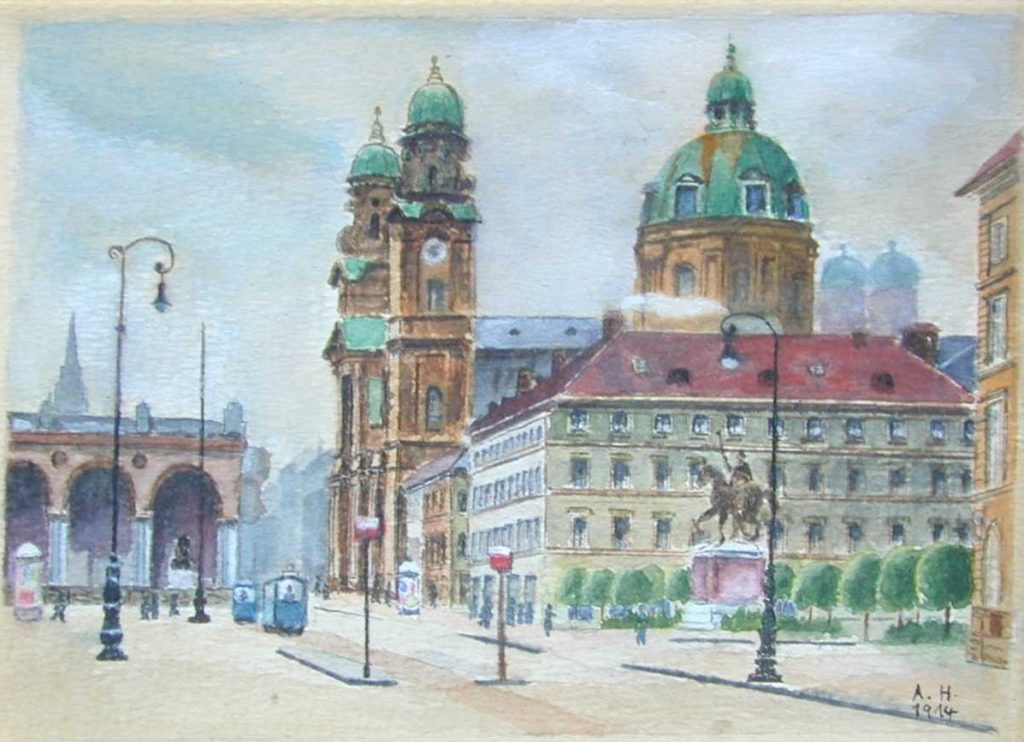
Hitler continued to paint as Führer just kept his piece of work private. In his book, Spotts writes that Hitler had artistic talent, admitting small, lacked the technique of a trained pupil and ofttimes failed to capture passion in his work. Regardless, it was a hobby he genuinely enjoyed and felt he was quite knowledgeable about. He may accept been delusional about fine art, too as several other things, just he was not hypocritical or certifiably insane regarding art. Spotts presents a large documentary record of letters, journals, and enlightening illustrations which make Hitler's seriousness and dedication to art quite clear.
The determination and dedication glimpsed in Hitler's artistic oeuvre provide u.s. with scenes nosotros can interpret equally visions of the purified land he fantasized about. On the flip side, his fluffed, mellow landscapes of old rock churches, country houses, castles, bouquets of flowers, famous landmarks, and snowy countrysides bring to lite one of the most troubling facts of all: one of history's greatest monsters was a man, too.
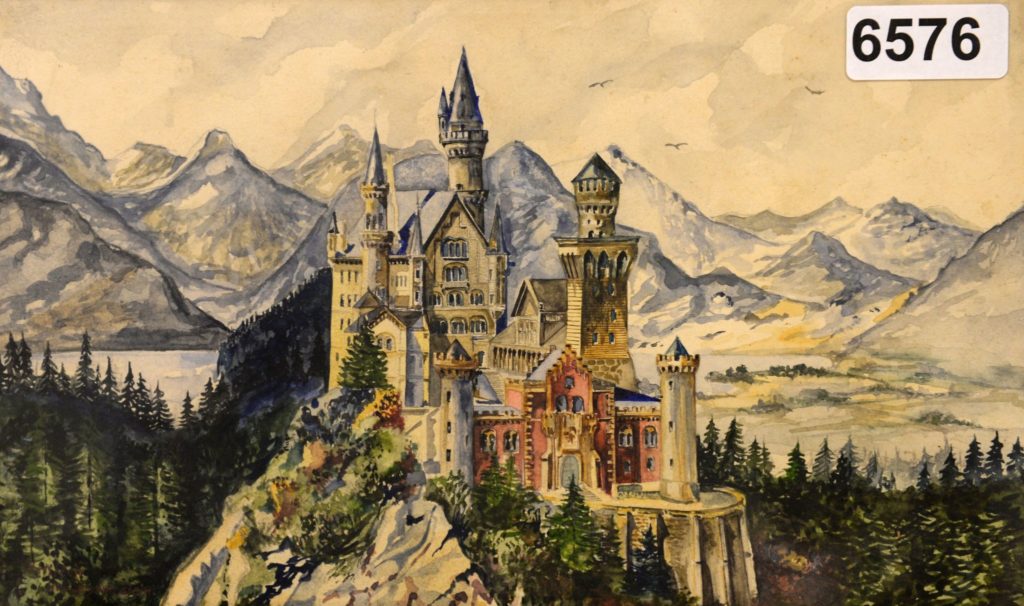
Read also:
Source: https://www.dailyartmagazine.com/art-hitler/
0 Response to "The Art of Adolf Hitler a Study of His Paintings and Drawings"
Post a Comment